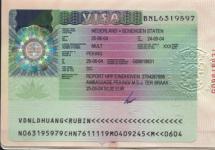The world's population is unevenly distributed, with about half of the world's population living on 5% of the inhabited land area. Undeveloped lands occupy 15% of the land area. The average population density is 51 people/sq. km. There are relatively few large areas with a relatively high population density (over 100 people per 1 sq. km): Europe (without its northern part); in Asia - the Indo-Gangetic lowland, South India, East China, the Japanese islands, the island of Java; in Africa - the Nile valley and the lower reaches of the Niger; in America - some coastal areas in the northeast of the USA, in Brazil and Argentina. Among the most densely populated countries in the world are Bangladesh (more than 1000 people per 1 sq. km), the Republic of Korea, Puerto Rico, Rwanda - 400 - 500 people per 1 sq. km. km, the Netherlands and Belgium - 330 - 395 people per 1 sq. km. km, and in urban areas the population density often reaches several thousand people per 1 sq. km. km (cities such as Manila (43,000 people / sq. km), Mumbai (22,000 people / sq. km) have the highest indicator. The lowest population density is typical for Mongolia, Australia, Namibia, Mauritania (less than 3 people per sq. km). 1 sq. km).
Rice. 1. World population density map
(the darker the color, the higher the population density indicator)
Factors affecting the uneven distribution of the population:
1. Natural conditions. Highlands, deserts, tundra, glacial territories are unfavorable for human habitation and are practically uninhabited. On the contrary, 80% of the total population lives in the lowlands and altitudes up to 500 meters. Most of the population is concentrated in the subequatorial and subtropical zones.
2. Historical features of the settlement. Initially, man settled in East Africa, Southern Europe and Southwest Asia, then spread to other parts of the world.
3. Differences in the demographic situation. Countries with high natural growth also have high population densities.
4. Socio-economic conditions. Most of the population gravitate towards coastal areas, especially in Australia, Europe, and America. More than 50% of the total population lives in a 200-kilometer strip along the coasts. In the industrial centers of Europe, the average population density reaches 1500 people/sq. km.
5. Migration of the population.
Population migration(mechanical movement of the population) - the movement of people associated with a permanent or temporary change of residence.
Migrations happen:
1. Domestic (within the country).
2. External.
Types of migrations:
1. Emigration (from the country).
2. Immigration (to the country).
Classification of migrations by reasons:
1. Economic.
2. Social.
3. Cultural.
4. Political.
5. Military.
6. National-racial.
7. Religious.
The main reason for population migration is economic (socio-economic).
In addition, migrations are legal and illegal.
About 2/3 of all migrants come from developing countries. People from these countries migrate to countries with better living conditions. Migrant exporting countries: Pakistan, Bangladesh, India, Turkey, Algeria, Uzbekistan, Morocco, Indonesia, Philippines, etc. Migrant receiving countries: USA, Russia, Germany, France, Netherlands, Canada, Australia, Belgium.
The main areas (centers) of attraction for migrants:
1. Western Europe (Germany, France, Great Britain, Switzerland, the Netherlands).
2. USA and Canada.
3. Oil-producing countries of the Persian Gulf (UAE, Qatar, Kuwait).
4. Russia.
5. Newly industrialized countries of Asia (Singapore, Republic of Korea).
6. Australia, Israel and South Africa.
7. Large centers of Latin America.

Rice. 2. Migrants in France
Homework
Topic 3, P. 3
1. What factors influence the distribution of the population?
2. Using statistical materials, the Internet, calculate the population density of the countries you like.
Bibliography
Main
1. Geography. A basic level of. 10-11 cells: Textbook for educational institutions / A.P. Kuznetsov, E.V. Kim. - 3rd ed., stereotype. - M.: Bustard, 2012. - 367 p.
2. Economic and social geography of the world: Proc. for 10 cells. educational institutions / V.P. Maksakovskiy. - 13th ed. - M .: Education, JSC "Moscow textbooks", 2005. - 400 p.
3. Atlas with a set of contour maps for grade 10. Economic and social geography of the world. - Omsk: Federal State Unitary Enterprise "Omsk Cartographic Factory", 2012. - 76 p.
Additional
1. Economic and social geography of Russia: Textbook for universities / Ed. prof. A.T. Khrushchev. - M.: Bustard, 2001. - 672 p.: ill., cart.: tsv. incl.
2. Bazhenov S.A. Quality of life of the population: theory and practice / S.A. Bazhenov. - M.: ECOS, 2002. - 178 p.
3. Vasilyeva E.K. Statistics: Proc. allowance / E.K. Vasiliev. - M.: Finance, 2008. - 399 p.
4. Vasiliev V.P. Quality and standard of living of the population of the Russian Federation / V.P. Vasiliev. - M.: ECOS, 2007. - 117 p.
5. Vorobieva O. D . Migration processes of the population: issues of theory and state migration policy // Problems of legal regulation of migration processes on the territory of the Russian Federation / Analytical collection of the Federation Council of the Federal Assembly of the Russian Federation - 2003. - No. 9 (202). - S. 35.
6. Iontsev V. A . International population migration: theory and history of study. - M.: Dialog-MGU, 1999. - S. 19.
7. Migration of the population. Issue 1. Theory and practice of research. Supplement to the journal "Migration in Russia". - M., 2001. - S. 18.
8. Alisov N. V., Khorev B. S. Economic and social geography of the world (general review). - M., 2000.
9. Kopylov V. A. Population geography. - M., 2000.
10. Socio-economic geography of the foreign world / ed. V. V. Volsky. - M., 2001.
Encyclopedias, dictionaries, reference books and statistical collections
1. Geography: a guide for high school students and university applicants. - 2nd ed., corrected. and dorab. - M.: AST-PRESS SCHOOL, 2008. - 656 p.
2. Gusarov V.M. Statistics: Proc. allowance / V.M. Gusarov. - M.: UNITI-DANA, 2007. - 479 p.
Literature for preparing for the GIA and the Unified State Examination
1. Thematic control in geography. Economic and social geography of the world. Grade 10 / E.M. Ambartsumova. - M.: Intellect-Centre, 2009. - 80 p.
2. The most complete edition of typical options for real USE assignments: 2010. Geography / Comp. Yu.A. Solovyov. - M.: Astrel, 2010. - 221 p.
3. The optimal bank of tasks for preparing students. Unified State Exam 2012. Geography: Textbook / Comp. EM. Ambartsumova, S.E. Dyukov. - M.: Intellect-Centre, 2012. - 256 p.
4. The most complete edition of typical options for real USE assignments: 2010. Geography / Comp. Yu.A. Solovyov. - M.: AST: Astrel, 2010. - 223 p.
5. State final certification of 9th grade graduates in a new form. Geography. 2013: Textbook / V.V. Drums. - M.: Intellect-Centre, 2013. - 80 p.
6. Geography. Diagnostic work in the format of the Unified State Examination 2011. - M .: MTSNMO, 2011. - 72 p.
7. USE 2010. Geography. Collection of tasks / Yu.A. Solovyov. - M.: Eksmo, 2009. - 272 p.
8. Tests in geography: Grade 10: to the textbook by V.P. Maksakovskiy “Economic and social geography of the world. Grade 10 / E.V. Baranchikov. - 2nd ed., stereotype. - M.: Publishing house "Exam", 2009. - 94 p.
9. The most complete edition of typical options for real USE assignments: 2009. Geography / Comp. Yu.A. Solovyov. - M.: AST: Astrel, 2009. - 250 p.
10. Unified state exam 2009. Geography. Universal materials for the preparation of students / FIPI - M .: Intellect-Center, 2009. - 240 p.
Materials on the Internet
1. Federal Institute of Pedagogical Measurements ().
2. Federal portal Russian Education ().
4. The official information portal of the exam ().



